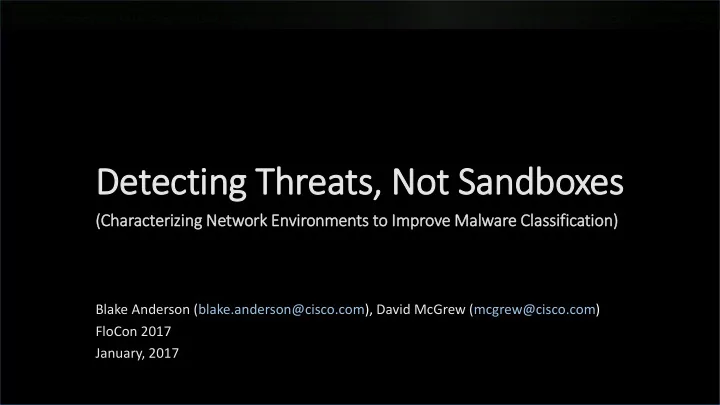

Detecting Threats, Not Sandboxes (C (Characterizin ing Ne Network Environments to o Im Improve Mal alware Clas lassification) Blake Anderson (blake.anderson@cisco.com), David McGrew (mcgrew@cisco.com) FloCon 2017 January, 2017
Data Collection and Training Malware Sandbox ... Malware Sandbox Malware Classifier/Rules Training/Storage Records ... Benign Records • Metadata • Packet lengths • TLS • DNS • HTTP
Deploying Classifier/Rules Enterprise A ... … Classifier/Rules Enterprise N ...
Problems with this Architecture • Models will not necessarily translate to new environments • Will be biased towards the artifacts of the malicious / benign collection environments • Collecting data from all possible end-point/network environments is not always possible
Network Features in Academic Literature • 2016 – IMC / USENIX Security / NDSS • Packet sizes • Length of URLs • 2012:2015 – CCS / SAC / ACSAC / USENIX Security • Time between ACKs • Packet sizes in each direction • Number of packets in each direction • Number of bytes in each direction
Network/Transport-Level Robustness
Ideal TCP Session
Inbound Packet Loss
Multi-Packet Messages
Collection Points / MTU / Source Ports • Collection points significantly affect packet sizes • Same flow collected within a VM and on the host machine will look very different • Path MTU can alter individual packet sizes • Source ports are very dependent on underlying OS • WinXP: 1024-5000 • NetBSD: 49152-65535
Application-Level Robustness
TLS Handshake Protocol Client Server ClientHello ServerHello / Certificate ClientKeyExchange / ChangeCipherSpec ChangeCipherSpec Application Data
TLS Client Fingerprinting OpenSSL Versions ClientHello Record Headers 1.0.2 1.0.1 Random Nonce [Session ID] 1.0.0 Cipher suites 0.9.8 Compression Indicative of TLS Client Methods Extensions
TLS Dependence on Environment • 73 unique malware samples were run under both WinXP and Win7 • 4 samples used the exact same TLS client parameters in both environments • 69 samples used the library provided by the underlying OS (some also had custom TLS clients) • Effects the distribution of TLS parameters • Also has secondary effects w.r.t. packet lengths
HTTP Dependence on Environment • 152 unique malware samples were run under both WinXP and Win7 • 120 samples used the exact same set of HTTP fields in both environments • 132 samples used the HTTP fields provided by the underlying OS’s library • Effects the distribution of HTTP parameters • Also has secondary effects w.r.t. packet lengths
Solutions
Potential Solutions • Collect training data from target environment • Ground truth is difficult • Models do not translate • Discard Biased Samples • Not always obvious which features are network/endpoint-independent • Train models on network/endpoint-independent features • Not always obvious which features are network/endpoint-independent • This often ignores interesting behavior • Modify existing training data to mimic target environment • Not always obvious which features are network/endpoint-independent • Can capture interesting network/endpoint-dependent behavior • Can leverage previous capture/curated datasets
Results • L1-logistic regression • L1-logistic regression • Meta + SPLT + BD • Meta + SPLT + BD + TLS • 0.01% FDR: 1.3% • 0.01% FDR: 92.8% • Total Accuracy: 98.9% • Total Accuracy: 99.6%
Results (without Schannel) • L1-logistic regression • L1-logistic regression • Meta + SPLT + BD • Meta + SPLT + BD + TLS • 0.01 FDR: 0.9% • 0.01 FDR: 87.2% • Total Accuracy: 98.5% • Total Accuracy: 99.6%
Conclusions • It is necessary to understand and account for the biases present in different environments • Helps to create more robust models • Models can be effectively deployed in new environments • We can reduce the number of false positives related to environment artifacts • Data collection was performed with: Joy
Thank You
Recommend
More recommend